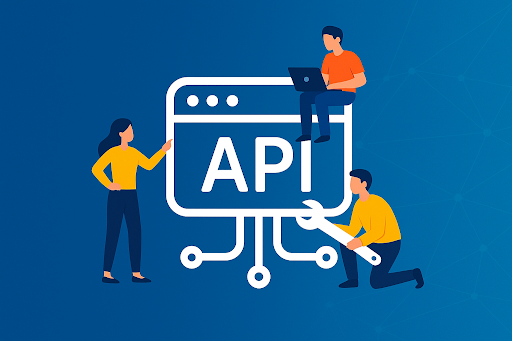In this article, we outline the different stages that a project to create custom software goes through; as well as the average time each stage takes. Each project is unique and takes a different length of time to complete.
However, most of the projects we work on, on average, fall into the categories discussed further in this blog. Continue reading if you're thinking about creating custom software and want to know how long it takes to build one for your enterprise.
An Overview of the Software Development Stages

To begin with let’s delve into the different stages how to create a software product.
In the requirements gathering, design and wireframing phase you will have a clear plan for your software application including all decisions that will have a financial impact. This ensures that the implementation can begin with few or no surprises.
This is followed by scheduling, planning, and development of the application. A project manager plans the work of creative designers, technical architects, software engineers, etc. when it comes to software.
The software structure and foundation are designed by architects, the user experience is crafted by creative designers, and the logic is implemented by software engineers. The software is built in all aspects at this point, and is handed over to you to get an initial feel of the application.
You must ensure that the application satisfies certain requirements before you deploy it. Then the final stage of the project that remains is the software testing phase.
Let’s take a look at the software development timelines of the different stages of the application development process.
Requirements Gathering, Wireframing and Design

The requirements, wireframing and design phase in software development is predictable and condensed. As the main stakeholder and decision-maker, we begin by collaborating with your IT team to keep track of the system requirements and the things that the software must be able to accomplish.
We then work together to develop various concepts and application elements that will cohere to fulfil your system needs. We then discuss your user capabilities the application must address and the application's ideal appearance and feel.
The application design or your application blueprint is documented, reviewed, and any last-minute adjustments are charted out. Finally the project's initial scope is defined as to what are the features you are building in the first release vs. later releases.
A requirements gathering & wireframing phase normally lasts between three weeks or a month. The product timeline is largely determined by your team's availability, responsiveness to design reviews and questions, and the speed at which important decisions are made.
Strategising, Architecture Design & Writing Code

Laying out every task in chronological sequence, allocating resources, and determining which activities can be completed simultaneously and which cannot constitute the strategising phase. Prior to beginning development work, planning and strategising is a quick activity that lasts 3 to 4 days.
The system needs a foundation or structure to build upon after planning is complete. Which technologies will be employed and how they will interact are determined by the technical architecture. Similar to planning, technical architecture is often simple unless the project entails intricate system interconnections or applies novel or not so predominant technology. Depending on the size and complexity of the system, this software development schedule typically takes 2-3 weeks.
Coding the application takes up the most time in software development. You might be wondering as to how long this aspect of the custom software development process takes. The application is normally constructed in 4-6 months once the system is conceived and the technical underpinning is chosen.
This is the stage of the project where the time frame is most frequently accelerated. Additional development resources can be introduced to speed up the effort when there are many tasks to complete. But eventually, the extra resources will actually result in less efficiency because more coordination and planning will be required, not to mention that people will start stepping on each other's toes.
Bug Fixing and Application Testing

There are numerous types of testing that should and ought to be employed, depending on your project. End-to-end testing and user acceptance testing should be performed on every project. End-to-end testing involves putting a system's features and capabilities to use just as a user would. Features are tested individually but not together during development. Once all of the software has been created, an end-to-end test puts the entire system through its paces. This enables the tester to assess how closely the finished product adheres to the original design intent as well as any changes that may have been made along the way.
During a user acceptance test (UAT), you, the stakeholder, utilise the system and give your approval for the deployment. It is your responsibility to examine everything, find any problems that the testers might have overlooked, and begin preparing for production.
You can also choose to have extra testing done, including load testing, performance testing, integration testing, cross-browser or cross-mobile device testing. If your application will be used on a variety of browsers or mobile platforms, you can test it on a variety of browsers and platforms to make sure it appears and functions properly on any browsers or platforms that your user may select.
With all this we have come to the final leg of exploring how long does software development take?
Load and performance testing should be taken into consideration if your application will have many users logged in at once, process a lot of data, or respond to users in a short amount of time. Load and performance testing, respectively, determines the slowest parts of your programme and confirms that it can manage high loads.
Integration testing should be taken into account if your application will interact with systems from other companies. This is to ensure that two systems can gracefully manage all known and unknown permutations of data and situations. Also integration testing delivers both expected and unexpected data over the connection of two systems.
We see that the majority of testing efforts take between three and six weeks, depending on the size of your application and the depth of the required testing.
Conclusion
At Deventure we have been developing reliable and cost effective custom software solutions for various clients within relatively shorter program development timelines as compared to the industry standards, and we would be delighted to collaborate with you on yours.
Software development and design projects typically take 5 to 9 months to complete. The main determinants of overall length are the project's size and complexity.
Monitoring these risks is a part of a project manager's responsibility so they may be found early and reduced to keep the project on schedule.
So if you have a great software project idea we can help you make it a reality well within your budget and timelines.






